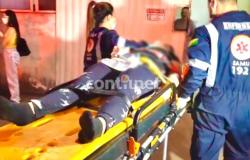March 27, 2004 is a dark chapter carved into the memory of people from Santa Catarina. 20 years ago, the State was a victim of “Hurricane Catarina”. It was the first time that this titanic force – a truly unwanted visit, was recorded in the South Atlantic, leaving around 11 dead and several families displaced.
Image taken by a NASA satellite, at the time when Hurricane Catarina was heading towards the State — Photo: NASA/Disclosure/ND
The phenomenon occurred in the southern regions of Santa Catarina and the North Coast of Rio Grande do Sul. Hurricane Catarina, born from the tumultuous depths of the South Atlantic, left traces of despair and devastation.
There were around 14 municipalities that declared a State of Public Calamity and seven of Emergency. In addition, around 33,165 thousand people were homeless and 78 people were injured.
Still according to Civil Defense data, the economic losses were more than R$850 million. Ten fishermen and a driver — whose vehicle was hit by a falling tree — died during the meteorological phenomenon.
The director of Civil Defense at the time, Márcio Luiz Alves, recalls that Santa Catarina was not prepared for such events at that time. However, avoiding something even worse, the State Government had structured bodies that allowed decision-making.
“We had to be sure to prevent panic from setting in among the people of Santa Catarina and measures were taken at the opportune moment”, recalls Alves.
Could Hurricane Catarina come back to haunt Santa Catarina?
Meteorologist Piter Scheuer explains that the phenomenon could happen again. However, the possibilities are very low.
 Hurricane Catarina hit the State in early autumn 2004 — Photo: Archive/Civil Defense of SC/Disclosure
Hurricane Catarina hit the State in early autumn 2004 — Photo: Archive/Civil Defense of SC/DisclosureAccording to the expert, for the phenomenon to repeat itself, several atmospheric factors needed to align. From a subtropical cyclone to the formation of a tropical storm and finally a hurricane.
“This is an extremely rare event, occurring only every two or three decades, or even more,” he says.
As stated by Scheuer, understanding and predicting such phenomena is a challenge, the only way to know if it will happen is by following weather updates.
Typhoon, hurricane and cyclone: expert explains the difference between the phenomena
 Region formed by the phenomenon determines nomenclature — Photo: Personal archive/Piter Scheuer/ND
Region formed by the phenomenon determines nomenclature — Photo: Personal archive/Piter Scheuer/NDPiter Scheuer states that “hurricanes, tropical cyclones and typhoons are all the same phenomena”.
He explains that they are all a rotating system organized by storm clouds that originate in certain oceans, and, to be determined as one of the three, the wind speed must reach at least 120 km/h.
But why the difference in nomenclature?
According to the expert, scientists name phenomena depending on the region where they occur.

As stated by Scheuer, understanding and predicting such phenomena is a challenge – Twitter/Reproduction/ND

“Hurricanes, tropical cyclones and typhoons are all the same phenomena” – Pexels/Reproduction/ND

For the phenomenon to repeat itself, several atmospheric factors needed to align – NOAA/RAAMB/Disclosure/Reproduction/AFP
If a phenomenon of this type manifests itself in the north of the Atlantic Ocean and northeast of the Pacific, the name used is “hurricane”, or hurricane in English, due to the Caribbean God of evil, called Hurrican.
On the other hand, if the storm occurs in the northwestern Pacific Ocean, the name used is “typhoon”. As for the cyclone, it comprises a tropical storm that takes shape in the South Pacific and Indian Ocean.
Extratropical cyclone and tropical cyclone
It is worth mentioning that extratropical cyclones, which are nothing new for Santa Catarina residents, are caused by a cold front and a warm front. They are more common because temperature variations occur constantly in the atmosphere.
Hurricane season
In the United States, it is common to hear on certain stations that they are going through “hurricane season”, which runs from June 1st to November 30th in the region. Typhoon and cyclone seasons follow different patterns.
In the northeast Pacific, the official season runs from May 15th to November 30th. In the Pacific Northwest, typhoons are most common from late June to December. And the northern Indian Ocean sees cyclones from April to December.
The strongest storms, equivalent to category 5 on the Saffir-Simpson scale, suffered winds exceeding 250 km/h. By comparison, Hinnamor, the current typhoon in eastern Japan, has winds estimated at 257 km/h, by the Joint Typhoon Forecast Center.
Tags: Hurricane Catarina years expert reveals likelihood phenomenon returning
--











